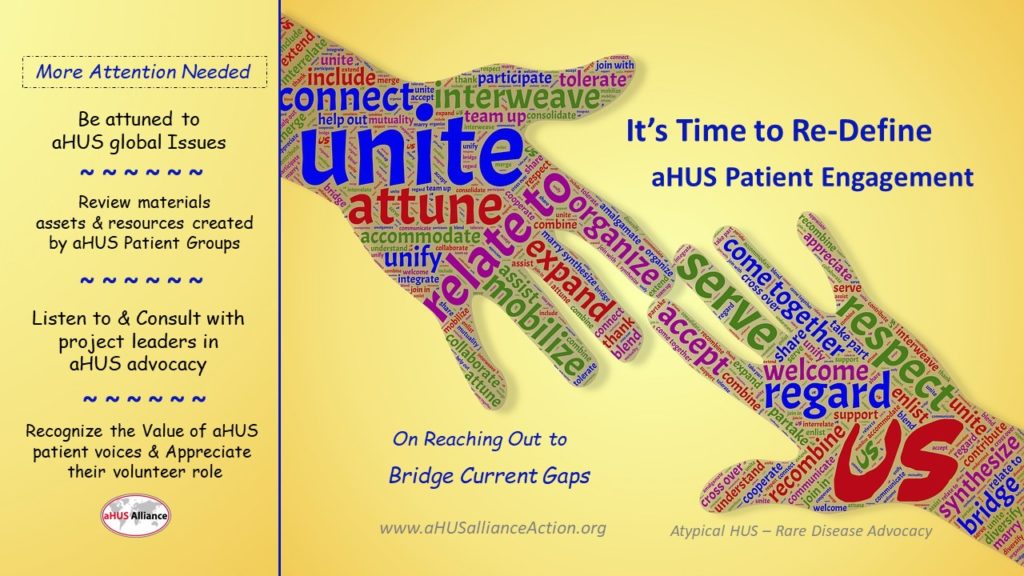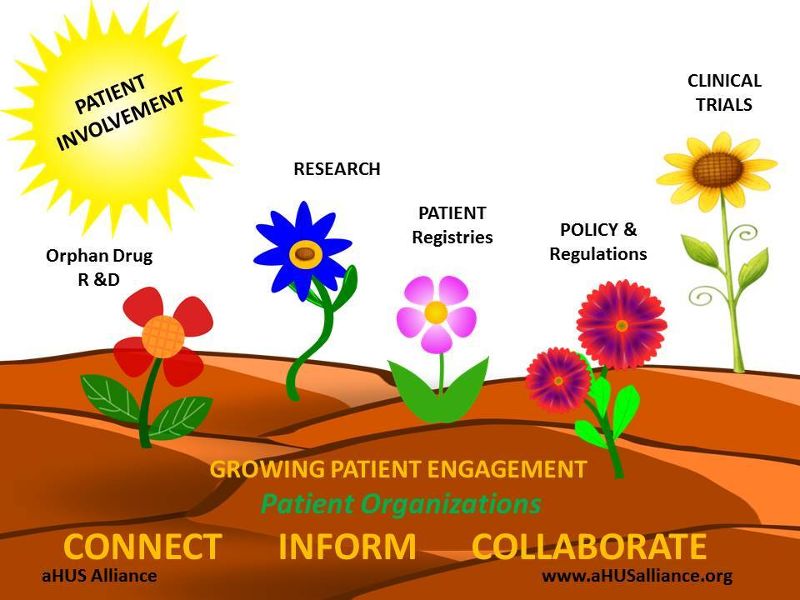Reaching out to Bridge Current Gaps

As complement research has progressed and more is understood about thrombotic microangiopathy, it’s interesting that atypical HUS patient organizations still run into the same ‘patient engagement’ barriers that have remained in place for more than a decade. Historically, among past difficulties are these issues and areas for improvement:
Atypical HUS advocates are almost exclusively unpaid volunteers, usually with some loss of work/vacation hours and with advocacy calls or events which almost always require that we must adjust our schedules or daily life to participate. Yet seldom is our time valued, early input sought, or recognition noted for our role as meaningful contributors.
*Lack of understanding about issues facing atypical HUS patients and their families.
*Assumptions by outside interests that among rare disease communities, atypical HUS concerns closely pattern after those for other rare disease groups.
*Creation of initiatives, and announcement of project launches, which were embarked upon without input from aHUS patient organizations.
*Lack of understanding which yields unrepresentative survey results and ineffective patient recruitment efforts, since subsets of aHUS patient profiles have not been included nor considered.
*Conversations with industry which indicate they haven’t perused websites of aHUS patient organizations or conducted a review of what key issues exist, despite their ability to do a background check of aHUS social media for evidence of patient-directed efforts and assets.
A well-trodden path doesn’t necessarily equate to reaching one’s desired destination. It seems as if no one is looking at the ‘why’ behind difficulties with patient recruitment for clinical trials and surveys. During virtual conferences, phone calls, and email conversations held in 2021 the aHUS Alliance global action team has participated with various efforts which follow familiar pathways. Why hasn’t past patient engagement and involvement been more productive? It’s not due to lack of interest from patients or aHUS patient organizations. There continues to be high interest from patients and caregivers, with data regarding their wish to participate in aHUS research. The finding that most families wished to be included in research efforts is supported by the 2016 aHUS global poll results from Section 5: ‘Research: Patient Participation’ (Questions 29-34). Of the 233 respondents from 23 nations participating in this 2016 survey, 60% answered that they’d participated in aHUS research and/or would like to do so again. A further 36% responded that they have not, but would like to know how to do so (Q29). See our 2021 & other aHUS poll info HERE.
It’s past time to re-examine patient engagement within the aHUS space, and to consider more effective means to include patient voices to move things forward. Great benefits can be reaped from some pretty simple and common-sense adjustments.
*Be attuned to aHUS global issues
While the internet brought more access to information about rare diseases, development of Facebook (launched 2004) provided a way for families to reach out, find, and form relationships with others affected by their rare condition. Patients and family caregivers have reached out to globally connect online, often creating groups to include national aHUS organizations within the aHUS Alliance R.O.W. initiative.
No matter where aHUS families are located, it’s not surprising that there are certain common concerns which affect them and their loved ones battling this rare disease. Yet these vary by regions or country, as national rare disease policy and healthcare structure governs aHUS treatment and drug access. The regulatory environment in any given nation also dictates parameters for important aspects such as pharma or communication interactions with patients, and with guidelines for their interface with patient organizations.
Patients, family caregivers, and aHUS advocates around the world participated in a multi-year project that culminated in the aHUS Patients’ Global Research Agenda. If you’re interested in the aHUS arena, this document will provide a snapshot of background vital to understand before designing aHUS patient engagement projects or outreach efforts.
*Review materials, assets & resources created by aHUS Patient Groups
The aHUS Alliance launched its first aHUS Awareness Day in 2015, and the aHUS Alliance Global Action team annually hosts outreach for this yearly 24 September campaign on Twitter at @aHUS24Sept. All national aHUS patient groups are invited (and encouraged) to share information, efforts, and materials they’ve created so that their outreach and visibility can be seen by a broader audience.
Equally important to a review of aHUS assets is knowing the context or reasons behind them- ‘why’ those articles, projects, and resources were created in the first place. What’s the driving force behind something like “Know aHUS: Know Us”, and what determined its selection as an asset which is available as a print-friendly download in three languages?
Some may be surprised at the sheer number of our website articles dedicated to topics like aHUS terminology, family genetics, thrombotic microangiopathy, and complement, since the original content on www.aHUSallianceAction.org isn’t written by professionals but by aHUS patients and family caregivers. Yes, unpaid volunteers who are dedicated to showcasing the type of information which actual aHUS families wish to know – and aptly demonstrating abilities and interest with an authentic and independent voice of aHUS global advocacy.
No business would enter a market without a clear understanding of all its aspects. Yet how many research teams, marketing companies, communication firms, or other professional interests take the time to review existing aHUS resources? Which national aHUS patient groups have developed assets and are active across various platforms? What’s the background or driving force behind certain aHUS patient-led initiatives?
*Listen to & Consult with leaders patient-led in aHUS advocacy
While every single patient has a unique story to tell, rare disease patients almost always have an extra-ordinary journey. That’s especially true for atypical HUS patients and their families. It’s not just the rarity of the disease nor that our patient population is so small, but rather that aHUS symptoms and clinical presentation vary dramatically from patient-to-patient. Even for members within the same family, no case of aHUS is quite like another in terms of organs affected, severity of symptoms, and duration of illness.
While considering whether/when to undertake patient engagement in any rare disease population, it’s key that industry insiders have background for each particular rare condition, not only medically but also in regard to identifying patient needs and concerns. When a company searches for aHUS efforts which are patient-led, do they take the next step of discovering its leadership and what led up to creation of particular projects?
In our experience, no – and we find that perplexing. Atypical HUS patient advocates who have past experience with patient engagement/recruitment efforts are a wealth of information in terms of what paths have been explored prior and to their degree of success. Context and a historical perspective provide hard-won but authentic patient insights, for who else but aHUS patients and family caregivers will always be committed to long-term information sharing and advocacy. Over the years while medical or research staff may change and new scientific knowledge advance, aHUS families remain engaged by necessity and are steadfast as dedicated advocates.
Click HERE for a quick look at topics of interest to patient advocates around the world, as defined and explained from actual patient and caregiver viewpoints and experiences. Patient-centered care and patient engagement, most simply and at its core, means industry and academics taking the time to connect, listen, and ask questions that better inform their efforts and practices.
*Recognize the value of aHUS patient voices & appreciate their volunteer role
Our disease does not define us, and we have the same busy lives and responsibilities as experienced by the rest of the human race. Except aHUS patients and family caregivers must additionally squeeze in medical treatments, lab tests, dialysis appointments, and endless phone conversations related to healthcare (or accommodations necessitated by them).
You’ll find that aHUS patients and family caregivers often volunteer their time to help inform people and groups with an interest in atypical HUS. We aHUS families have little free time with the extra efforts demanded of any rare disease family, yet no one else can convey aHUS experiences with authenticity forged of experience. That’s why it’s so disheartening to receive a call or email noting the launch of an broad initiative that falls short of the intent simply because people didn’t include patient input at early stages. “Oh, we didn’t realize that.” or “We’ll send it back to our colleagues, and explain why this needs to be reworked.” Wouldn’t it be more effective, as well as more time- and cost-efficient, to gather background and context by integrating aHUS patient and caregiver input at concept stages?
Know that offers to share aHUS experiences don’t come from paid staff but from volunteer aHUS families willing to give up a few of our lunch hours, a bit of vacation time, and even some of our precious time with family or friends. That should convey how important we consider it is to add our voice to deepen discussions and provide insight into the aHUS patient experience for medical professionals, researchers or corporate interests.
Unfortunately, some interactions have included senior staff who merely tolerate patient representatives for appearance sake, and which sometimes don’t even end with a ‘thank you for your time’. In the past aHUS patients have been invited to speaking engagements where their travel costs would be reimbursed post-event, an economic stress for those already burdened by healthcare costs. Some aHUS patients are invited to engage at corporate or professional events, but only to ‘tell their story’ rather than more fully participating in the event with deeper dialogue and purpose. At times we’ve been charged with what essentially is bringing new staff ‘up to speed’ after personnel changes or corporate restructuring of divisions. Value our time, questions, and ideas as much as we value your work to improve aHUS information flow and patient outcomes.
Where do we go from here? We’ve identified the many benefits when aHUS patients and family caregivers are included early and often, and why it’s important to ‘do the homework’ of exploring background information behind existing aHUS efforts and resources. We hope to see more movement toward a more patient centric approach for aHUS patient engagement and recruitment, and the aHUS Alliance Global Action team is dedicated to doing all we can to promote that as we follow the tagline commitment noted on our website’s home page: Connect, Inform, Collaborate.


